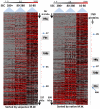Characterizing the Escherichia coli O157:H7 proteome including protein associations with higher order assemblies
- PMID: 22087229
- PMCID: PMC3210124
- DOI: 10.1371/journal.pone.0026554
Characterizing the Escherichia coli O157:H7 proteome including protein associations with higher order assemblies
Abstract
Background: The recent outbreak of severe infections with Shiga toxin (Stx) producing Escherichia coli (STEC) serotype O104:H4 highlights the need to understand horizontal gene transfer among E. coli strains, identify novel virulence factors and elucidate their pathogenesis. Quantitative shotgun proteomics can contribute to such objectives, allowing insights into the part of the genome translated into proteins and the connectivity of biochemical pathways and higher order assemblies of proteins at the subcellular level.
Methodology/principal findings: We examined protein profiles in cell lysate fractions of STEC strain 86-24 (serotype O157:H7), following growth in cell culture or bacterial isolation from intestines of infected piglets, in the context of functionally and structurally characterized biochemical pathways of E. coli. Protein solubilization in the presence of Triton X-100, EDTA and high salt was followed by size exclusion chromatography into the approximate M(r) ranges greater than 280 kDa, 280-80 kDa and 80-10 kDa. Peptide mixtures resulting from these and the insoluble fraction were analyzed by quantitative 2D-LC-nESI-MS/MS. Of the 2521 proteins identified at a 1% false discovery rate, representing 47% of all predicted E. coli O157:H7 gene products, the majority of integral membrane proteins were enriched in the high M(r) fraction. Hundreds of proteins were enriched in a M(r) range higher than that predicted for a monomer supporting their participation in protein complexes. The insoluble STEC fraction revealed enrichment of aggregation-prone proteins, including many that are part of large structure/function entities such as the ribosome, cytoskeleton and O-antigen biosynthesis cluster.
Significance: Nearly all E. coli O157:H7 proteins encoded by prophage regions were expressed at low abundance levels or not detected. Comparative quantitative analyses of proteins from distinct cell lysate fractions allowed us to associate uncharacterized proteins with membrane attachment, potential participation in stable protein complexes, and susceptibility to aggregation as part of larger structural assemblies.
Conflict of interest statement
Figures



Similar articles
-
Characteristics of the Shiga-toxin-producing enteroaggregative Escherichia coli O104:H4 German outbreak strain and of STEC strains isolated in Spain.Int Microbiol. 2011 Sep;14(3):121-41. doi: 10.2436/20.1501.01.142. Int Microbiol. 2011. PMID: 22101411 Review.
-
Different Cellular Origins and Functions of Extracellular Proteins from Escherichia coli O157:H7 and O104:H4 as Determined by Comparative Proteomic Analysis.Appl Environ Microbiol. 2016 Jun 30;82(14):4371-4378. doi: 10.1128/AEM.00977-16. Print 2016 Jul 15. Appl Environ Microbiol. 2016. PMID: 27208096 Free PMC article.
-
Comparison of clinical and immunological findings in gnotobiotic piglets infected with Escherichia coli O104:H4 outbreak strain and EHEC O157:H7.Gut Pathog. 2017 May 25;9:30. doi: 10.1186/s13099-017-0179-8. eCollection 2017. Gut Pathog. 2017. PMID: 28559930 Free PMC article.
-
Fitness of Enterohemorrhagic Escherichia coli (EHEC)/Enteroaggregative E. coli O104:H4 in Comparison to That of EHEC O157: Survival Studies in Food and In Vitro.Appl Environ Microbiol. 2016 Oct 14;82(21):6326-6334. doi: 10.1128/AEM.01796-16. Print 2016 Nov 1. Appl Environ Microbiol. 2016. PMID: 27542931 Free PMC article.
-
Methods for the detection and isolation of Shiga toxin-producing Escherichia coli.Symp Ser Soc Appl Microbiol. 2000;(29):133S-143S. doi: 10.1111/j.1365-2672.2000.tb05341.x. Symp Ser Soc Appl Microbiol. 2000. PMID: 10880188 Review.
Cited by
-
Analysis of the proteome of intracellular Shigella flexneri reveals pathways important for intracellular growth.Infect Immun. 2013 Dec;81(12):4635-48. doi: 10.1128/IAI.00975-13. Epub 2013 Oct 7. Infect Immun. 2013. PMID: 24101689 Free PMC article.
-
Proteomic View of Interactions of Shiga Toxin-Producing Escherichia coli with the Intestinal Environment in Gnotobiotic Piglets.PLoS One. 2013 Jun 19;8(6):e66462. doi: 10.1371/journal.pone.0066462. Print 2013. PLoS One. 2013. PMID: 23840478 Free PMC article.
-
Quantification of enterohemorrhagic Escherichia coli O157:H7 protein abundance by high-throughput proteome.PLoS One. 2018 Dec 31;13(12):e0208520. doi: 10.1371/journal.pone.0208520. eCollection 2018. PLoS One. 2018. PMID: 30596662 Free PMC article.
-
Growth media simulating ileal and colonic environments affect the intracellular proteome and carbon fluxes of enterohemorrhagic Escherichia coli O157:H7 strain EDL933.Appl Environ Microbiol. 2013 Jun;79(12):3703-15. doi: 10.1128/AEM.00062-13. Epub 2013 Apr 5. Appl Environ Microbiol. 2013. PMID: 23563955 Free PMC article.
-
Integrated next-generation sequencing of 16S rDNA and metaproteomics differentiate the healthy urine microbiome from asymptomatic bacteriuria in neuropathic bladder associated with spinal cord injury.J Transl Med. 2012 Aug 28;10:174. doi: 10.1186/1479-5876-10-174. J Transl Med. 2012. PMID: 22929533 Free PMC article.
References
-
- Perna NT, Plunkett G, 3rd, Burland V, Mau B, Glasner JD, et al. Genome sequence of enterohaemorrhagic Escherichia coli O157:H7. Nature. 2001;409:529–533. - PubMed
-
- Denamur E. The 2011 Shiga toxin-producing Escherichia coli O104:H4 German outbreak: a lesson in genomic plasticity. Clin Microbiol Infect. 2011;17:1124–1125. - PubMed
-
- Hyde R. Germany reels in the wake of E coli outbreak. Lancet. 2011;377:1991. - PubMed
-
- Griffin PM, Ostroff SM, Tauxe RV, Greene KD, Wells JG, et al. Illnesses associated with Escherichia coli O157:H7 infections. A broad clinical spectrum. Ann Intern Med. 1988;109:705–712. - PubMed
Publication types
MeSH terms
Substances
Grants and funding
LinkOut - more resources
Full Text Sources
Other Literature Sources

